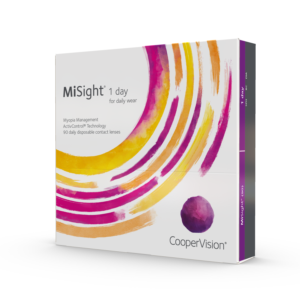November 2, 2021
 SAN RAMON, Calif. — At the 2021 American Academy of Optometry Meeting in Boston, CooperVision announced the results from its seven-year pivotal clinical trial on MiSight 1 day contact lenses. Ultimately, 12 months after treatment, axial elongation data showed no rebound effect.1,2†
SAN RAMON, Calif. — At the 2021 American Academy of Optometry Meeting in Boston, CooperVision announced the results from its seven-year pivotal clinical trial on MiSight 1 day contact lenses. Ultimately, 12 months after treatment, axial elongation data showed no rebound effect.1,2†
In the study’s seventh year, participants were transitioned from MiSight 1 day to a single vision contact lens to evaluate if treatment gains would be retained. Myopic progression then occurred only at anticipated “age-normal” levels — not at an accelerated “catch up” rate that would offset prior myopia control gains.1,2 This indicates no rebound effect.
“Our unparalleled research clearly illustrates the tremendous potential of MiSight 1 day for children of different ages and with different levels of myopia, regardless of when they start treatment.3 With these results, eye care professionals should be even more confident in prescribing MiSight 1 day,” said Paul Chamberlain, BSc (Hons), MCOptom, the study’s principal investigator and CooperVision Director of Research Programs.

Paul Chamberlain, BSc (Hons), MCOptom, presented the results from CooperVision’s seven-year trial on MiSight 1 day contact lenses at AAO 2021.
The latest data analysis illustrates that MiSight 1 day offers a highly desired proportional myopia control treatment effect. Abnormal axial length growth slowed by an average of approximately 50% with all tested ages (8-17).4 Because younger children’s myopia progresses faster than older children’s,5 introducing MiSight 1 day at the earliest opportunity may offer the maximum cumulative benefit over time.4
“We saw these children grow into young adults during their seven years in the study. It is personally, as well as professionally, fulfilling to know that the benefits of treatment are retained. As MiSight 1 day becomes more widely available and as myopia management becomes the standard of care, I hope other eye care professionals will experience that same joy,” said study investigator Nicola Logan, PhD, Professor of Optometry and Physiological Optics, Aston University.
References
† Preliminary international study data shows that, on average, for children that discontinued treatment at age 14-19 following 3 or 6 years of MiSight® 1 day wear, the eye growth reverted to age-expected average myopic progression rates.
1 Chamberlain P, Arumugam B, et al. Myopia Progression on Cessation of Dual-Focus Contact Lens Wear: MiSight 1 day 7-Year Findings. Optom Vis Sci 2021;98:E-abstract 210049
2 Hammond D, Arumugam B, et al. Myopia Control Treatment Gains are Retained after Termination of Dual-focus Contact Lens Wear with No Evidence of a Rebound Effect. Optom Vis Sci 2021;98:E-abstract 215130
3 Arumugam B, Chamberlain P, Bradley A et al. The Effects of Age on Myopia Progression with Dual-Focus and Single Vision Daily Disposable Contact Lenses. OptomVis Sci 2020;97(E-abstract):205340, AAO 2020 Poster
4 Arumugam et al. Modelling age effects of myopia progression for the MiSight 1 day clinical trial. ARVO 2021
5 Chua, Sharon & Sabanayagam, Charumathi & Cheung, Yin-Bun & Chia, Audrey & Valenzuela, Robert & Tan, Donald & Wong, T-Y & Cheng, Ching-yu & Saw, Seang-Mei. (2016). Age of onset of myopia predicts risk of high myopia in later childhood in myopic Singapore children. Ophthalmic and Physiological Optics. 36. 388-394. 10.1111/opo.12305













